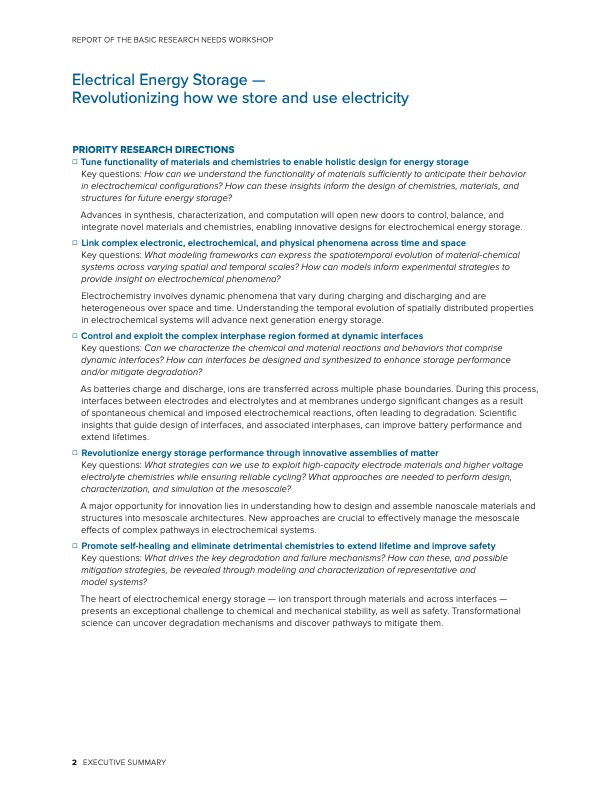
PDF Publication Title:
Text from PDF Page: 008
REPORT OF THE BASIC RESEARCH NEEDS WORKSHOP Electrical Energy Storage — Revolutionizing how we store and use electricity PRIORITY RESEARCH DIRECTIONS ☐ Tune functionality of materials and chemistries to enable holistic design for energy storage Key questions: How can we understand the functionality of materials sufficiently to anticipate their behavior in electrochemical configurations? How can these insights inform the design of chemistries, materials, and structures for future energy storage? Advances in synthesis, characterization, and computation will open new doors to control, balance, and integrate novel materials and chemistries, enabling innovative designs for electrochemical energy storage. ☐ Link complex electronic, electrochemical, and physical phenomena across time and space Key questions: What modeling frameworks can express the spatiotemporal evolution of material-chemical systems across varying spatial and temporal scales? How can models inform experimental strategies to provide insight on electrochemical phenomena? Electrochemistry involves dynamic phenomena that vary during charging and discharging and are heterogeneous over space and time. Understanding the temporal evolution of spatially distributed properties in electrochemical systems will advance next generation energy storage. ☐ Control and exploit the complex interphase region formed at dynamic interfaces Key questions: Can we characterize the chemical and material reactions and behaviors that comprise dynamic interfaces? How can interfaces be designed and synthesized to enhance storage performance and/or mitigate degradation? As batteries charge and discharge, ions are transferred across multiple phase boundaries. During this process, interfaces between electrodes and electrolytes and at membranes undergo significant changes as a result of spontaneous chemical and imposed electrochemical reactions, often leading to degradation. Scientific insights that guide design of interfaces, and associated interphases, can improve battery performance and extend lifetimes. ☐ Revolutionize energy storage performance through innovative assemblies of matter Key questions: What strategies can we use to exploit high-capacity electrode materials and higher voltage electrolyte chemistries while ensuring reliable cycling? What approaches are needed to perform design, characterization, and simulation at the mesoscale? A major opportunity for innovation lies in understanding how to design and assemble nanoscale materials and structures into mesoscale architectures. New approaches are crucial to effectively manage the mesoscale effects of complex pathways in electrochemical systems. ☐ Promote self-healing and eliminate detrimental chemistries to extend lifetime and improve safety Key questions: What drives the key degradation and failure mechanisms? How can these, and possible mitigation strategies, be revealed through modeling and characterization of representative and model systems? The heart of electrochemical energy storage — ion transport through materials and across interfaces — presents an exceptional challenge to chemical and mechanical stability, as well as safety. Transformational science can uncover degradation mechanisms and discover pathways to mitigate them. 2 EXECUTIVE SUMMARYPDF Image | Next Generation Electrical Energy Storage

PDF Search Title:
Next Generation Electrical Energy StorageOriginal File Name Searched:
BRN-NGEES_rpt-low-res.pdfDIY PDF Search: Google It | Yahoo | Bing
Sulfur Deposition on Carbon Nanofibers using Supercritical CO2 Sulfur Deposition on Carbon Nanofibers using Supercritical CO2. Gamma sulfur also known as mother of pearl sulfur and nacreous sulfur... More Info
CO2 Organic Rankine Cycle Experimenter Platform The supercritical CO2 phase change system is both a heat pump and organic rankine cycle which can be used for those purposes and as a supercritical extractor for advanced subcritical and supercritical extraction technology. Uses include producing nanoparticles, precious metal CO2 extraction, lithium battery recycling, and other applications... More Info
| CONTACT TEL: 608-238-6001 Email: greg@infinityturbine.com | RSS | AMP |